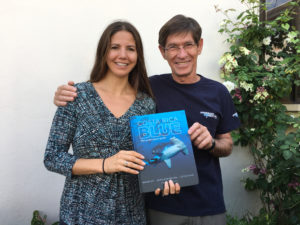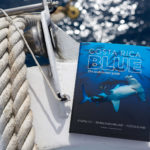 Cocos Island — and Costa Rica in general — is on the top of many divers’ bucket lists. And for good reason — its Pacific waters are filled with the pelagics divers dream of, from schooling hammerheads to wandering whale sharks. Written and produced by Genna Marie Davis with photography by Avi Klapfer, one of the founders of the Undersea Hunter Group, “Costa Rica Blue” takes great care to introduce readers to each and every one of them. The 337-page coffee-table book is a visual delight starting from the inside cover, which features a huge school of scalloped hammerheads.
Cocos Island — and Costa Rica in general — is on the top of many divers’ bucket lists. And for good reason — its Pacific waters are filled with the pelagics divers dream of, from schooling hammerheads to wandering whale sharks. Written and produced by Genna Marie Davis with photography by Avi Klapfer, one of the founders of the Undersea Hunter Group, “Costa Rica Blue” takes great care to introduce readers to each and every one of them. The 337-page coffee-table book is a visual delight starting from the inside cover, which features a huge school of scalloped hammerheads.
And, rather than wasting the dust covers on summaries or reviews, Davis has instead filled them with useful information. The front dust-cover features a quick reference guide to page numbers for each of the animals in the book; and the back dust-cover features a guide to seasonality for each region of Costa Rica so you can time your trip perfectly. The pages between these two handy guides hold descriptions of nearly every dive site — and animal — you may encounter in Costa Rica.
Davis has divided the book into four main parts: a brief introduction, a section on marine life, a section on scuba diving and snorkeling, and a conclusion. Each section is color-coordinated as well, so you can jump right to what you want to read. Readers will, of course, spend most of their time in the middle two sections, looking up either specific animals or specific dive sites and regions.

Marine Life
The marine-life section begins with sharks — which is apt, since that’s what most divers have come to see. Costa Rica’s waters are home to dozens of shark species, but Davis concentrates on the 14 most common. All but two, she says, inhabit Cocos Island, which represents the pinnacle of Costa Rica diving — and maybe the world. Before she breaks into individual shark species, however, Davis takes the time to explain a bit about these apex predators to the readers. She offers information on all of sharks’ senses, including sight, smell, electroreception, touch, taste, and sound & vibration.
She begins coverage of individual sharks with the iconic scalloped hammerhead, so closely associated with Cocos Island. Readers will get a chart of facts about each shark, including information on their distribution, scientific name, weight, lifespan and more. Each species then gets between two and eight pages, filled with more tidbits about the shark, including the best dive sites to see them.
After the shark section, the marine-life section is further broken down into ones on rays, marine mammals, sea turtles, fish, eels and invertebrates. Each entry provides some quick facts as well as the best place to see each animal.
Scuba Diving & Snorkeling
Just as useful as the marine-life section of “Costa Rica Blue” is the dive-site section. Here you can search the country based on potential destination rather than possible animal sightings. She’s broken the geographic areas of the country down into Cocos Island, the North Pacific, Central and South Pacific, and Caribbean.
Cocos Island gets over 100 pages, the lion’s share of the section. Further, there are three more subsections here: ‘Discover Cocos Island,’ ‘History,’ and ‘Dive Sites.’ Any potential Cocos diver would be wise to pore over these pages, filled with interesting factoids, such as average air and water temperature and the best dive sites for each and every animal that calls the island home.
The North Pacific and Central & South Pacific sections offer plenty of details as well, beginning with general descriptions of the area’s diving and seasonality and then drilling down into individual dive areas and sites. Divers planning a trip to the Pacific Costa Rican coast will want to spend some time in these two sections, and perhaps decide on a holiday destination accordingly.
Finally, Davis touches briefly on the diving off the Caribbean coast, which is quite limited due to inconsistent visibility. Although there are opportunities to splash in, Davis lets the reader know that any diving or snorkeling here should be an extra perk on a trip already planned.
Overall, “Costa Rica Blue” is an invaluable resource for anyone planning a trip to either the mainland or Cocos Island to dive. Even non-divers can enjoy the full-color spreads and copious information on a wide variety of marine life. And, after reading and seeing what they’re missing, they might just decide to join the fun underwater — in Costa Rica or elsewhere.
The post Book Review: Costa Rica Blue appeared first on Scuba Diver Life.
from Scuba Diver Life https://ift.tt/2FbBCcB
No comments:
Post a Comment